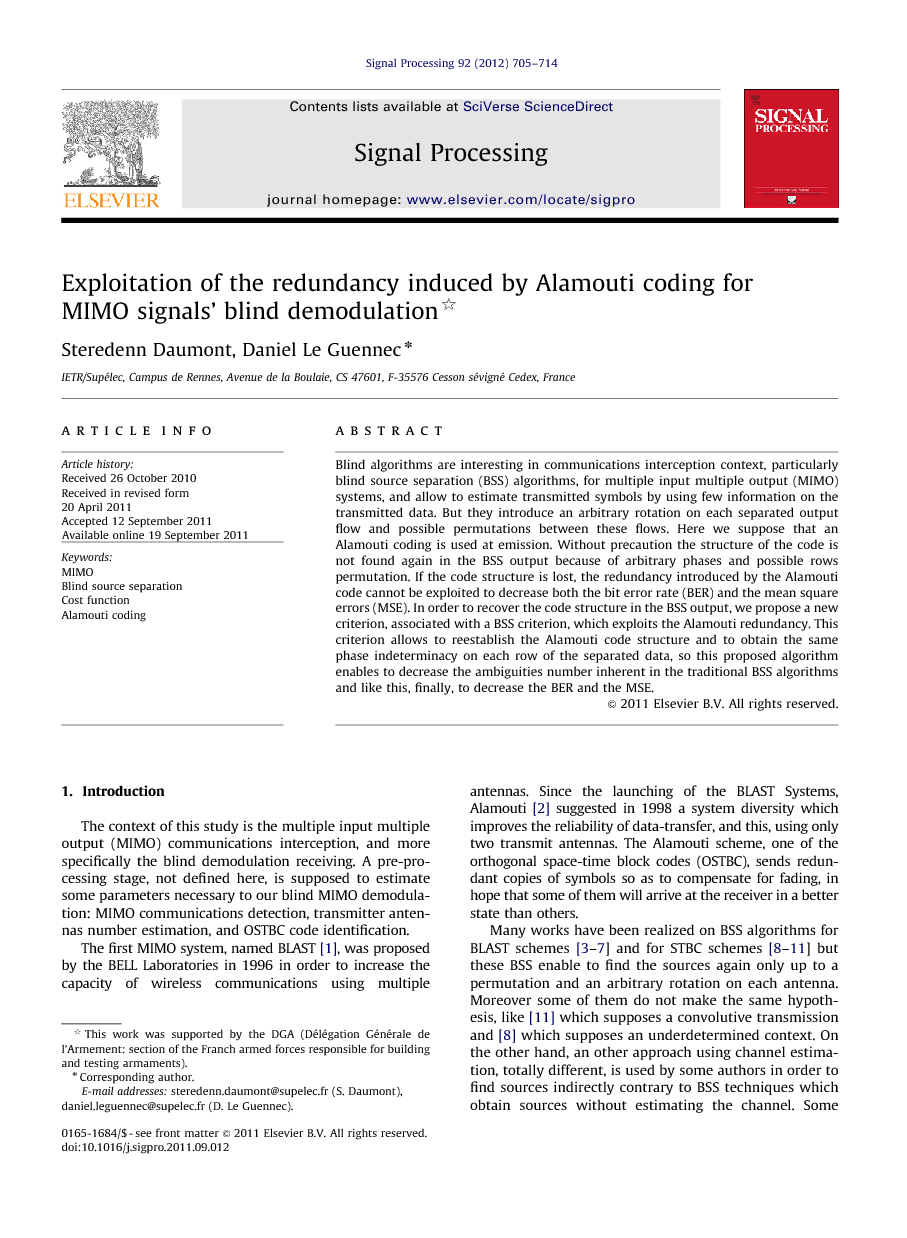Blind algorithms are interesting in communications interception context, particularly blind source separation (BSS) algorithms, for multiple input multiple output (MIMO) systems, and allow to estimate transmitted symbols by using few information on the transmitted data. But they introduce an arbitrary rotation on each separated output flow and possible permutations between these flows. Here we suppose that an Alamouti coding is used at emission. Without precaution the structure of the code is not found again in the BSS output because of arbitrary phases and possible rows permutation. If the code structure is lost, the redundancy introduced by the Alamouti code cannot be exploited to decrease both the bit error rate (BER) and the mean square errors (MSE). In order to recover the code structure in the BSS output, we propose a new criterion, associated with a BSS criterion, which exploits the Alamouti redundancy. This criterion allows to reestablish the Alamouti code structure and to obtain the same phase indeterminacy on each row of the separated data, so this proposed algorithm enables to decrease the ambiguities number inherent in the traditional BSS algorithms and like this, finally, to decrease the BER and the MSE.
The context of this study is the multiple input multiple output (MIMO) communications interception, and more specifically the blind demodulation receiving. A pre-processing stage, not defined here, is supposed to estimate some parameters necessary to our blind MIMO demodulation: MIMO communications detection, transmitter antennas number estimation, and OSTBC code identification.
The first MIMO system, named BLAST [1], was proposed by the BELL Laboratories in 1996 in order to increase the capacity of wireless communications using multiple antennas. Since the launching of the BLAST Systems, Alamouti [2] suggested in 1998 a system diversity which improves the reliability of data-transfer, and this, using only two transmit antennas. The Alamouti scheme, one of the orthogonal space-time block codes (OSTBC), sends redundant copies of symbols so as to compensate for fading, in hope that some of them will arrive at the receiver in a better state than others.
Many works have been realized on BSS algorithms for BLAST schemes [3], [4], [5], [6] and [7] and for STBC schemes [8], [9], [10] and [11] but these BSS enable to find the sources again only up to a permutation and an arbitrary rotation on each antenna. Moreover some of them do not make the same hypothesis, like [11] which supposes a convolutive transmission and [8] which supposes an underdetermined context. On the other hand, an other approach using channel estimation, totally different, is used by some authors in order to find sources indirectly contrary to BSS techniques which obtain sources without estimating the channel. Some works [12], [13], [14] and [15] and more recently [16], [17], [18], [19] and [20] use this method with OSTBC. These methods can be compared with our previous work [21] which uses this same approach with Alamouti coding and outperforms all of them. So, our goal here is to assess the use of BSS, with the adaptive algorithm CMA, for an Alamouti scheme, since only few works on this topic exist. In [22], we proposed a first approach to raise the indeterminacy order, but with the hypothesis that rotation ambiguities are perfectly raised. This supposition is not realistic, so we propose in this paper a more feasible solution.
Associated with a BSS criterion, a new criterion is suggested, making use of the redundancy induced by the Alamouti code. The proposed algorithm enables to recover the structure of the Alamouti code in the BSS output, allowing use of the redundancy induced by the Alamouti code and decreases so both BER and MSE. The works in [23] show theoretically that the properties of some OSTBC codes allow to estimate uniquely and blindly symbols up to a sign but that all ambiguities introduced by BSS cannot be raised with an Alamouti code. Our criterion cannot raise any more ambiguities but it allows to provide the sources in the BSS output with the same phase on each separator output flow.
First, we will introduce the system model. Section 3 shows the proposed criterion. Then, the separation criterion used with the proposed criterion is described. Then, the minima of the criterion associated with the Alamouti code are searched in Section 5. The criterion implementation is detailed in Section 6. Finally, Section 7 shows the simulation results obtained thanks to the proposed criterion. We conclude in Section 8.


